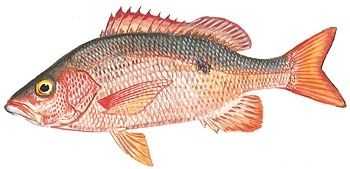Mahogany Snapper

Species Details
Lutjanus Mahogoni
Lutjanidae
Perciformes
Nearshore, Offshore, Coral Reefs
1 - 3 lbs.
15" - 19"
Mahogany Snapper (Lutjanus Mahogoni) Fish Description
The mahogany snapper is a vibrant, colorful reef fish. It is predominantly silver with an olive-gray top, pale belly, and unique black spot on the upper back, below the anterior dorsal fin rays. They may appear to have a red tint on the majority of their body, and the fins can have red-yellow edges. It can be confused with the lane snapper, except the latter has yellow stripes.
They have large eyes, with pointed mouths and a with a lower jaw that protrudes over the upper jaw, producing an “underbite” effect. The mahogany snapper’s anal fin is rounded, with a bi-lobed dorsal fin, long pectoral fin, and forked tails.
Diet and Size
The mahogany snapper feeds at night in moderately shallow waters over rocky beds of coral reefs. Their diet consists of small bottom-feeding fishes such as grunts, shrimp, crabs, cephalopods, and other fish.
On average, a mahogany snapper is a small fish, approximately 15 to 19 inches long. The IGFA world record is 3 pounds, caught in Miami, Florida in December 2019.
Interesting Facts About the Mahogany Snapper
- Although commercially sold for human consumption, this species has been connected to cases of ciguatera poisoning in the tropics
- The Spanish name Ojanco refers to its large eyes
- Mahogany snappers and their similar cousin, the lane snapper, attain their maximum size quicker than other fish in the same category but do not live as long
- They are one of the smaller snappers
- Snappers get their names from their enlarged teeth
Mahogany Snapper Habitat and Distribution
The mahogany snapper can typically be found on the rocky bottoms around waters with coral reefs, although they may frequent seagrass areas and man-made structures. During the day, they may school together but usually swim as single individuals.
A natural inhabitant of clear warm waters, they can live near shore or offshore, and will only be found in temperate areas during the summer months. They are typically found within the depth range of up to 325 feet.
The mahogany snapper is documented in the western Atlantic Ocean, Florida Keys, and the Caribbean, but are also known to be in the Gulf of Mexico and around Bermuda.
The spawning season for the mahogany snapper is usually from May to July in the northeastern Caribbean Sea. The females release the eggs in the ocean currents and the eggs hatch after one day of being fertilized. Young juveniles may be pale in color with slight pink-red hues, have dark stripes, and their distinct black spot already present on their lower later line.
Fishing Techniques: How To Catch Mahogany Snapper
The mahogany snapper is not a sought after game fish like the more popular red snapper but can provide good sport to anglers. The threat of ciguatera poisoning also does not make them entirely popular to eat, even though getting sick is quite rare.
Spinning and baitcasting with small hooks and sinkers are usually effective, along with the use of bait. Snappers are not particular eaters, and will essentially “snap” at anything. Any small baitfish will work with the mahogany snapper, but live crabs, squid, sardines, and shrimp are also effective.
Still fishing from a small boat in midrange depths is common for snappers. If anglers attempt to fish for mahogany snapper inshore, find a spot that is near some form of structure, whether it's a pier or rocky formations, and you will have a better chance of finding one.
When the current is mild, freelining can hook a mahogany snapper with your choice of bait. With a stronger current present, use a 1-ounce or 2-ounce sinker to float the baitfish on the bottom. Any light rod with a 30 to 40-pound braided line will work with this smaller snapper. To complete your rig, use a 1/0 Circle non-offset,non-stainless hook with a 20 lb. fluorocarbon leader.







